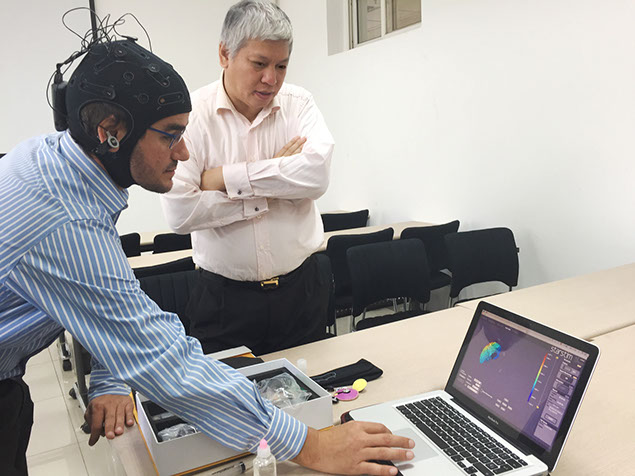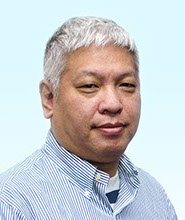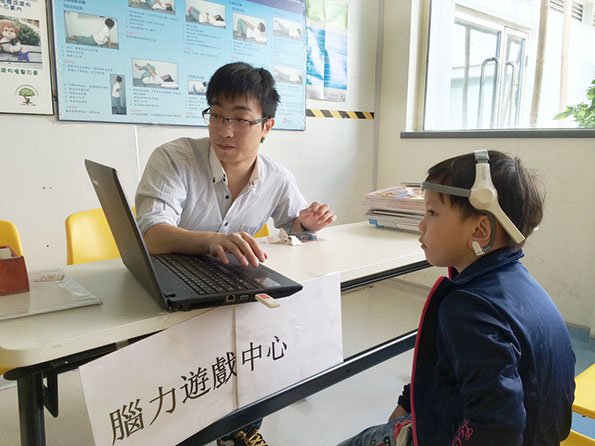Imagine the scene on the paediatrics ward of the Duchess of Kent Children’s Hospital when Dr Hu Yong and his team asked for patient volunteers to help test an invention that uses electrical signals from the brain to direct activity in a computer game. The response was immediate enthusiasm. “Even though they could use computers with their hands, they very much liked playing the game without their hands,” said Dr Hu, a biomedical engineer who is Director of the Lab of Neural Engineering and Clinical Electrophysiology in the Department of Orthopaedics and Traumatology.
Bringing such joy is one of the aims of his research, which seeks to develop new rehabilitation technologies for the physically disabled or impaired and improve the quality of life among the elderly. It is a fast-growing field thanks to advances in computer technologies.
The technology tested at the children’s hospital is but one example of his work. The subjects there were fitted with a cap of electrodes that transmitted their brain signals to a computer as they mentally selected characters from a keyboard and moved a mouse around the screen. The technology is not yet 100 per cent accurate, but Dr Hu and his team are continuing to refine it in the hope that it may help people who cannot speak or type communicate with the world.
A more immediately promising line of work uses robotics for rehabilitation. Dr Hu and his team have already developed a robotic hand prototype with the Institute of Biomedical Engineering of the Chinese Academy of Medical Sciences which can respond to sensory stimulation and grab objects. This won the best presentation award at the 2nd competition of China Brain-Computer Interface in 2015. The technology is being further refined to identify finger joint movements, so the potential range of movements can be increased.
“We want to see how well the hand grips, and if there is any spasm because spastic motions can cause fingers to jerk. We’re trying to see if the robotic hand can make the grabbing motion smooth and fast,” he said. “This could help patients with spasms but also a lot of elderly patients who have lost their normal hand function due to neurological disorders.”
Trying to improve function
Dr Hu said they also wanted to use the technology to improve function, rather than simply compensate for loss of function. One line of research is trying to help patients improve control over spasms by training their neural systems. This involves applying electric stimulation to subjects’ hands and asking them to mentally identify if it is the right or left hand while the computer monitors their brain activity.
Another line of exploration involves an exoskeleton that can walk and move its arms in response to signals from the brain. This could conceivably be done through voice control, but Dr Hu said employing the brain-computer interface instead could help enhance neurological repair by activating the sensory and motor neuron system. The project is expected to start in 2018 and also involves colleagues from the Li Ka Shing Faculty of Medicine and Faculty of Engineering at HKU, as well as the Hong Kong University of Science and Technology and the City University of Hong Kong.
Apart from using the brain-computer interface to enable movement, Dr Hu and his team have also developed a device that uses transcranial direct current stimulation for pain relief in patients with chronic pain. Subjects were fitted with a cap of dry electrodes and a little box about the size of a mobile phone charger that sends signals to the brain to modulate the sensation of pain. In clinical trials, patients reported that the pain intensity was reduced by about 20 per cent on a scale of 1 to 10, in about 80 per cent of the cases. This approach could be particularly effective for problems like chronic lower back pain, which can flare up unexpectedly, he said.
“It is not easy to guess when the pain will come and go. If you rely on taking painkillers, you would need to take them every day, but there are side effects to these drugs. This device can help patients feel more comfortable by reducing pain in their daily life,” he said.
He hoped to be able to translate more research into clinical applications. “My Lab’s main concern is to develop new technologies that can benefit more and more people, especially the elderly. In future we may be able to provide a robotic assistant device at home that could help them with lifting heavy objects or doing simple daily activities, and improve their quality of life,” he said.

UP For GRABS
Engineers working at the brain-computer interface are developing technologies that enable people to control computer activity and even robotic devices with their minds, and reduce pain.

![]() If you rely on taking painkillers, you would need to take them every day, but there are side effects to these drugs. This device can help patients feel more comfortable by reducing pain in their daily life.
If you rely on taking painkillers, you would need to take them every day, but there are side effects to these drugs. This device can help patients feel more comfortable by reducing pain in their daily life. ![]()
Dr Hu Yong
A trial of wireless brain-computer interface under the supervision of Dr Hu Yong.
Back
Brain-computer interface (BCI) Game Centre at the Duchess of Kent Children’s Hospital. A boy is playing a computer game by using BCI.

_01.png?crc=4174553115)
_12.png?crc=282960334)